Themed collection Nucleic Acid Modifications

Target specificity of mammalian DNA methylation and demethylation machinery
We review here the molecular mechanisms employed by DNMTs and TET enzymes that are responsible for shaping the DNA methylation pattern of a mammalian cell.

Org. Biomol. Chem., 2018,16, 1419-1435
https://doi.org/10.1039/C7OB02574B
25 years and still going strong: 2′-O-(pyren-1-yl)methylribonucleotides – versatile building blocks for applications in molecular biology, diagnostics and materials science
This review highlights the synthesis, biophysical properties, and wide range of applications of oligonucleotides modified with 2′-O-(pyren-1-yl)methyl-RNA monomers reported over the past 25 years.

Org. Biomol. Chem., 2017,15, 9760-9774
https://doi.org/10.1039/C7OB02152F
Synthesis and biological applications of fluoro-modified nucleic acids
The present review highlights recent progress in the synthesis of fluoro-modified nucleic acids, and their applications in diagnostics, and therapeutics, and as tools for probing the structure and function of nucleic acids by 19F NMR and MRI.
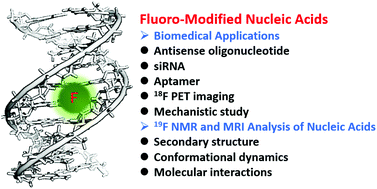
Org. Biomol. Chem., 2017,15, 9552-9565
https://doi.org/10.1039/C7OB02094E
Can 5-methylcytosine analogues with extended alkyl side chains guide DNA methylation?
The ability of extended forms of 5-methylcytosine to direct DNA methylation by maintenance DNA methyltransferase was investigated.
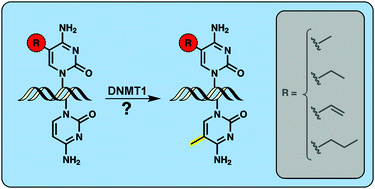
Chem. Commun., 2018,54, 1061-1064
https://doi.org/10.1039/C7CC06867K
Reversible modification of DNA by methyltransferase-catalyzed transfer and light-triggered removal of photo-caging groups
We developed analogs of S-adenosyl-L-methionine with photo-caging (PC) groups and demonstrated enzymatic transfer and light-triggered removal based on a DNA-methyltransferase and plasmid DNA.
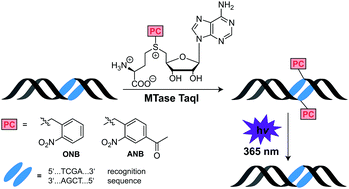
Chem. Commun., 2018,54, 449-451
https://doi.org/10.1039/C7CC08300A
Oxidative activation of leinamycin E1 triggers alkylation of guanine residues in double-stranded DNA
It may be useful to develop prodrugs that are selectively activated by oxidative stress in cancer cells to release cell-killing reactive intermediates.
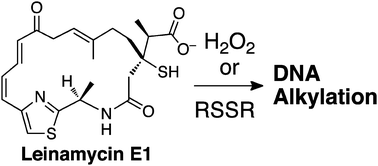
Chem. Commun., 2018,54, 256-259
https://doi.org/10.1039/C7CC08482J
Searching for avidity by chemical ligation of combinatorially self-assembled DNA-encoded ligand libraries
DNA encoded ligands are self-assembled into bivalent complexes and chemically ligated to link their identities.
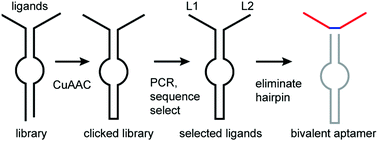
Org. Biomol. Chem., 2018,16, 48-52
https://doi.org/10.1039/C7OB02119D
5-(Hydroxymethyl)uracil and -cytosine as potential epigenetic marks enhancing or inhibiting transcription with bacterial RNA polymerase
5-(Hydroxymethyl)uracil and -cytosine in DNA templates regulate transcription by bacterial RNA polymerase depending on the promoter, indicating that they may act as epigenetic marks.
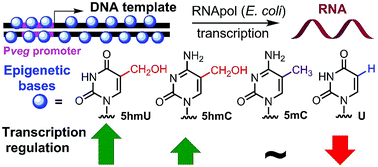
Chem. Commun., 2017,53, 13253-13255
https://doi.org/10.1039/C7CC08053K
Chemical synthesis and NMR spectroscopy of long stable isotope labelled RNA
A synthetic access to stable isotope modified large RNAs for structural biology is introduced.
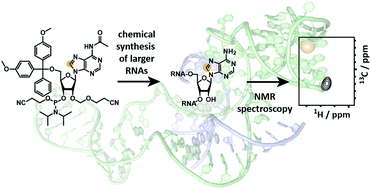
Chem. Commun., 2017,53, 12938-12941
https://doi.org/10.1039/C7CC06747J
Mapping platinum adducts on yeast ribosomal RNA using high-throughput sequencing
Methods to map small-molecule binding sites on cellular RNAs are important for understanding interactions with both endogenous and exogenous compounds. Here, ‘Pt-Seq’ is presented as a high-throughput method to identify Pt adducts on RNA resulting from cisplatin treatment.
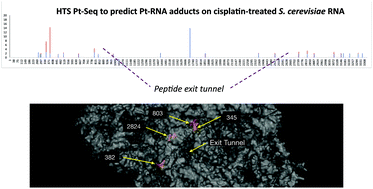
Chem. Commun., 2017,53, 12746-12749
https://doi.org/10.1039/C7CC06708A
Structural basis for the selective incorporation of an artificial nucleotide opposite a DNA adduct by a DNA polymerase
The structural basis for selective incorporation of BenziMP opposite O6-MeG by KlenTaq DNA polymerase is elucidated by X-ray crystallography.
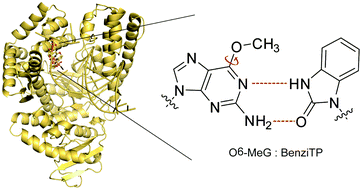
Chem. Commun., 2017,53, 12704-12707
https://doi.org/10.1039/C7CC07173F
Genetic alphabet expansion transcription generating functional RNA molecules containing a five-letter alphabet including modified unnatural and natural base nucleotides by thermostable T7 RNA polymerase variants
Thermostable T7 RNA polymerase variants were explored for genetic alphabet expansion transcription involving the unnatural Ds–Pa pair.
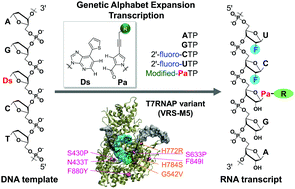
Chem. Commun., 2017,53, 12309-12312
https://doi.org/10.1039/C7CC06661A
Debranchase-resistant labeling of RNA using the 10DM24 deoxyribozyme and fluorescent modified nucleotides
The 10DM24 deoxyribozyme can site-specifically label RNAs with fluorophore-GTP conjugates. The phosphorothioate modification prevents enzymatic cleavage of the 2′,5′-branched RNA.
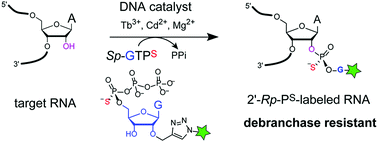
Chem. Commun., 2017,53, 11992-11995
https://doi.org/10.1039/C7CC06703H
Substoichiometric ribose methylations in spliceosomal snRNAs
Sequencing-based profiling of spliceosomal snRNA demonstrates substoichiometric methylation at cap-proximal and internal sites that may impact splicing and protein production.
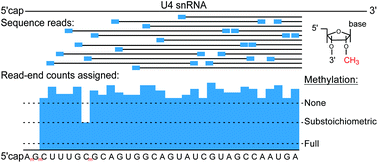
Org. Biomol. Chem., 2017,15, 8872-8876
https://doi.org/10.1039/C7OB02317K
Programmable fusion of liposomes mediated by lipidated PNA
Lipidated peptide nucleic acids as tools for efficient liposome fusion at elevated temperatures – in a zipper and a double-zipper fusion design. An potent alternative to DNA-mediated membrane fusion.
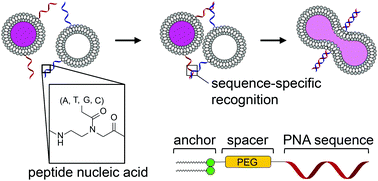
Chem. Commun., 2017,53, 11921-11924
https://doi.org/10.1039/C7CC06058K
Origins of the enhanced affinity of RNA–protein interactions triggered by RNA phosphorodithioate backbone modification
A single phosphorodithioate in place of a phosphate in a 19mer hairpin-RNA regio-specifically boosts its affinity for MS2 phage coat protein.
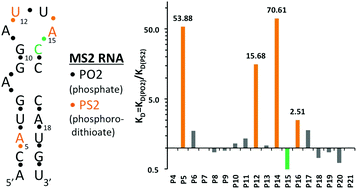
Chem. Commun., 2017,53, 10508-10511
https://doi.org/10.1039/C7CC05722A
Manipulation of a DNA aptamer–protein binding site through arylation of internal guanine residues
Chemically modified aptamers have the opportunity to increase aptamer target binding affinity and provide structure–activity relationships to enhance our understanding of molecular target recognition by the aptamer fold.
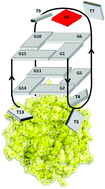
Org. Biomol. Chem., 2018,16, 3831-3840
https://doi.org/10.1039/C8OB00704G
Novel conformationally constrained 2′-C-methylribonucleosides: synthesis and incorporation into oligonucleotides
We have demonstrated the synthesis of ONs containing 2′-Me-locked nucleotide analogous (X) and (Y), and examined their biophysical properties.
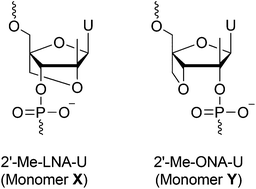
Org. Biomol. Chem., 2018,16, 1312-1321
https://doi.org/10.1039/C7OB02663C
Glycosylation of a model proto-RNA nucleobase with non-ribose sugars: implications for the prebiotic synthesis of nucleosides
The emergence of the earliest nucleosides is an important, but unresolved, element of the origins of life that may have been facilitated by heterocycle reactivity and self-assembly.
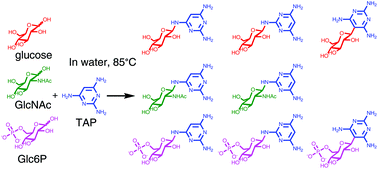
Org. Biomol. Chem., 2018,16, 1263-1271
https://doi.org/10.1039/C7OB03017G
A semi-rigid isoindoline-derived nitroxide spin label for RNA
The new semi-rigid spin label ImUm showed limited motion in RNA duplexes and accurate distances between two spin labels in RNA duplexes were obtained by pulsed EPR spectroscopy.
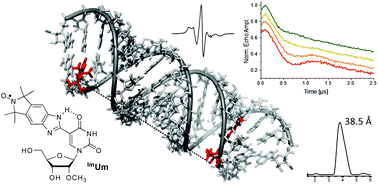
Org. Biomol. Chem., 2018,16, 816-824
https://doi.org/10.1039/C7OB02870A
Controlling miRNA-like off-target effects of an siRNA with nucleobase modifications
Structural information provides important insight to how major groove-modified triazole-containing siRNAs selectively knockout their intended target.

Org. Biomol. Chem., 2017,15, 10029-10036
https://doi.org/10.1039/C7OB02654D
Oligonucleotide modifications enhance probe stability for single cell transcriptome in vivo analysis (TIVA)
Transcriptome In Vivo Analysis (TIVA) probes capable of single cell mRNA isolation were generated with stabilizing oligonucleotide modifications, with the goal of enabling transcriptomic applications in a wide range of biological specimens.
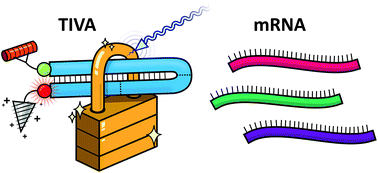
Org. Biomol. Chem., 2017,15, 10001-10009
https://doi.org/10.1039/C7OB02353G
Recognition of mixed-sequence DNA using double-stranded probes with interstrand zipper arrangements of O2′-triphenylene- and coronene-functionalized RNA monomers
Energetically activated double-stranded probes with interstrand arrangements of intercalator-functionalized nucleotides enable recognition of mixed-sequence DNA hairpins with excellent binding specificity.
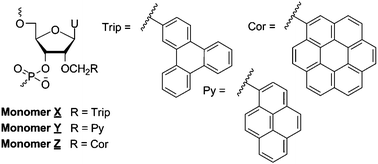
Org. Biomol. Chem., 2017,15, 9362-9371
https://doi.org/10.1039/C7OB01920C
Decoration of trastuzumab with short oligonucleotides: synthesis and detailed characterization
Trastuzumab, an antibody prescribed for the treatment of metastatic breast cancer, was covalently conjugated to oligonucleotides and characterized by high resolution MALDI-ToF MS.
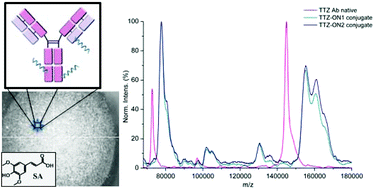
Org. Biomol. Chem., 2017,15, 8923-8928
https://doi.org/10.1039/C7OB02216F
Efficient liposome fusion mediated by lipid–nucleic acid conjugates
Highly efficient fusion and content mixing of liposomes encoded by lipidated oligonucleotides (LiNAs). “Hot fusion of biomembranes” – a low leakage process at elevated temperature.
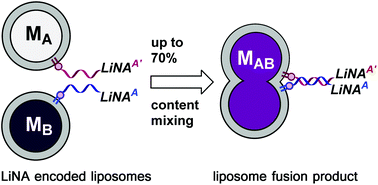
Org. Biomol. Chem., 2017,15, 8936-8945
https://doi.org/10.1039/C7OB01939D
Exploration of a Au(I)-mediated three-component reaction for the synthesis of DNA-tagged highly substituted spiroheterocycles
A gold(I)-mediated reaction to a DNA-tagged spirocycle, and the tolerance of different nucleic acids to the reaction conditions are demonstrated.

Org. Biomol. Chem., 2017,15, 8648-8654
https://doi.org/10.1039/C7OB02347B
Pseudouridine modifications influence binding of aminoglycosides to helix 69 of bacterial ribosomes
Pseudouridine modifications in helix 69 of bacterial ribosomes impact aminoglycoside interactions by altering the RNA conformational states and accessibility to chemical probes.
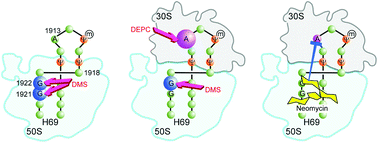
Org. Biomol. Chem., 2017,15, 8535-8543
https://doi.org/10.1039/C7OB02147J
8-Oxo-7,8-dihydro-2′-deoxyguanosine and abasic site tandem lesions are oxidation prone yielding hydantoin products that strongly destabilize duplex DNA
8-Oxo-2′-deoxyguanosine in a tandem lesion context is two orders of magnitude more susceptible to oxidation than in a context of native DNA yielding hydantoin products.
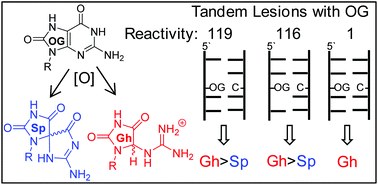
Org. Biomol. Chem., 2017,15, 8341-8353
https://doi.org/10.1039/C7OB02096A
Structural basis of interstrand cross-link repair by O6-alkylguanine DNA alkyltransferase
Conformation of the alkylene lesion may play a role in interstrand cross-link repair by O6-alkylguanine DNA alkyltransferases.

Org. Biomol. Chem., 2017,15, 8361-8370
https://doi.org/10.1039/C7OB02093G
Synthesis and thermal stabilities of oligonucleotides containing 2′-O,4′-C-methylene bridged nucleic acid with a phenoxazine base
BNAP-modified ODNs showed higher binding affinities toward complementary DNA and RNA as compared to ODNs bearing 2′,4′-BNA/LNA with 5-methylcytosine or 2′-deoxyribonucleoside with phenoxazine.
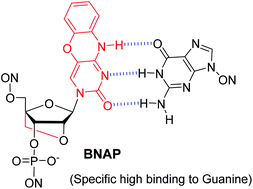
Org. Biomol. Chem., 2017,15, 8145-8152
https://doi.org/10.1039/C7OB01874F
Splitting a DNAzyme enables a Na+-dependent FRET signal from the embedded aptamer
The Na+-specific Ce13d DNAzyme is rigid showing no global folding in the presence of Na+, but splitting it at the cleavage site enables its Na+-specific folding detected by FRET.

Org. Biomol. Chem., 2017,15, 6959-6966
https://doi.org/10.1039/C7OB01709J
Phenothiazine-linked nucleosides and nucleotides for redox labelling of DNA
New phenothiazine-modified nucleotides were prepared and used for enzymatic synthesis of labelled DNA for electrochemical detection and redox coding of DNA bases.
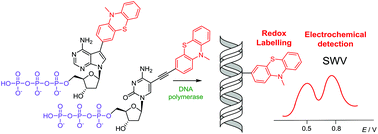
Org. Biomol. Chem., 2017,15, 6984-6996
https://doi.org/10.1039/C7OB01439B
Porphyrin-based photosensitizers and their DNA conjugates for singlet oxygen induced nucleic acid interstrand crosslinking
Porphyrin-based photosensitisers and their DNA conjugates have been evaluated for interstrand crosslink generation using furan containing oligonucleotides and red light.
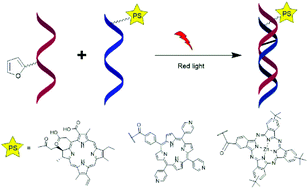
Org. Biomol. Chem., 2017,15, 5402-5409
https://doi.org/10.1039/C7OB01269A
Isonucleotide incorporation into middle and terminal siRNA duplexes exhibits high gene silencing efficacy and nuclease resistance
D-/L-Isonucleotides were used to explore the local conformation requirement at specific sites of siRNA; both silencing activity and nuclease resistant character were improved, respectively.
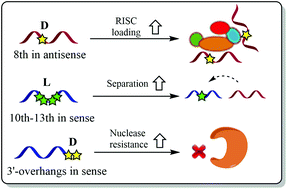
Org. Biomol. Chem., 2017,15, 5161-5170
https://doi.org/10.1039/C7OB01065F
On the enzymatic incorporation of an imidazole nucleotide into DNA
We have evaluated the possibility for using an imidazole modified nucleoside triphosphate for the enzymatic construction of artificial metal base pair with view on an expansion of the genetic code.
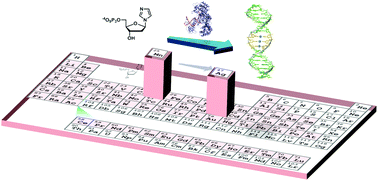
Org. Biomol. Chem., 2017,15, 4449-4455
https://doi.org/10.1039/C7OB00858A
About this collection
Nucleic acids are known for their predictable base-pairing that forms a key basis for their biological function as well as for various applications in chemistry, materials science, diagnostics, therapeutics, and elsewhere. Beyond the handful of canonical nucleic acid building blocks, scientists and nature itself have been very inventive in the creation of non-standard nucleic acids with augmented chemical functionalities.
This issue, Guest Edited by Professors Mark Helm, P. I. Pradeepkumar and Scott K. Silverman is dedicated to nucleic acid modifications and encompasses:
1. Synthetic modifications of DNA, RNA, or chemically related polymers; their characterization or application
2. Naturally occurring modifications of RNA or DNA; their synthesis, detection, or function
Articles in this themed collection will be added below as soon as possible after they are published.
Please return to this page frequently to see the collection grow.